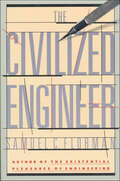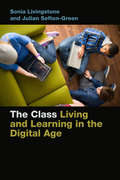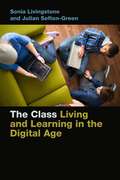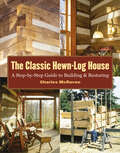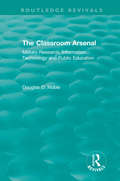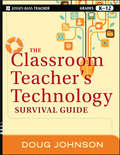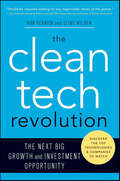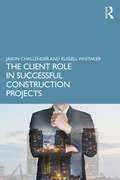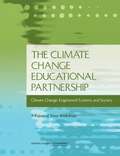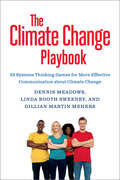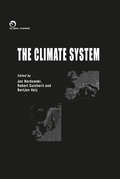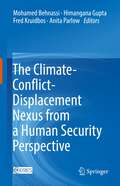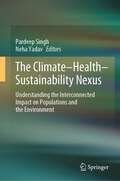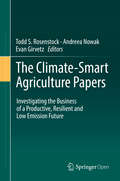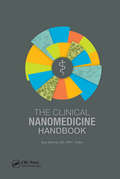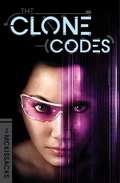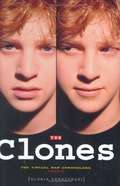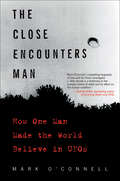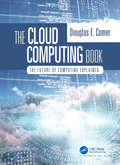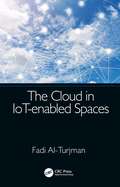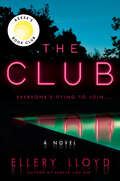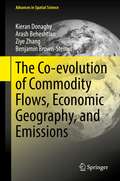- Table View
- List View
The Civilized Engineer
by Samuel C. FlormanCivil engineer Samuel C. Florman's The Civilized Engineer is aimed at both those observing and commenting externally on engineering, and the practicing engineer—to reveal something of the art behind great engineering achievements, and to stimulate debate upon the author's hypothesis that "in its moment of ascendance, engineering is faced with the trivialization of its purpose and the debasement of its practice."
The Class: Living and Learning in the Digital Age (Connected Youth and Digital Futures #1)
by Julian Sefton-Green Sonia LivingstoneAn intimate look at how children network, identify, learn and grow in a connected world.Read Online at connectedyouth.nyupress.orgDo today’s youth have more opportunities than their parents? As they build their own social and digital networks, does that offer new routes to learning and friendship? How do they navigate the meaning of education in a digitally connected but fiercely competitive, highly individualized world?Based upon fieldwork at an ordinary London school, The Class examines young people's experiences of growing up and learning in a digital world. In this original and engaging study, Livingstone and Sefton-Green explore youth values, teenagers’ perspectives on their futures, and their tactics for facing the opportunities and challenges that lie ahead. The authors follow the students as they move across their different social worlds—in school, at home, and with their friends, engaging in a range of activities from video games to drama clubs and music lessons. By portraying the texture of the students’ everyday lives, The Class seeks to understand how the structures of social class and cultural capital shape the development of personal interests, relationships and autonomy. Providing insights into how young people’s social, digital, and learning networks enable or disempower them, Livingstone and Sefton-Green reveal that the experience of disconnections and blocked pathways is often more common than that of connections and new opportunities.
The Class: Living and Learning in the Digital Age (Connected Youth and Digital Futures #1)
by Sonia Livingstone Julian Sefton-GreenAn intimate look at how children network, identify, learn and grow in a connected world.Read Online at connectedyouth.nyupress.orgDo today’s youth have more opportunities than their parents? As they build their own social and digital networks, does that offer new routes to learning and friendship? How do they navigate the meaning of education in a digitally connected but fiercely competitive, highly individualized world?Based upon fieldwork at an ordinary London school, The Class examines young people's experiences of growing up and learning in a digital world. In this original and engaging study, Livingstone and Sefton-Green explore youth values, teenagers’ perspectives on their futures, and their tactics for facing the opportunities and challenges that lie ahead. The authors follow the students as they move across their different social worlds—in school, at home, and with their friends, engaging in a range of activities from video games to drama clubs and music lessons. By portraying the texture of the students’ everyday lives, The Class seeks to understand how the structures of social class and cultural capital shape the development of personal interests, relationships and autonomy. Providing insights into how young people’s social, digital, and learning networks enable or disempower them, Livingstone and Sefton-Green reveal that the experience of disconnections and blocked pathways is often more common than that of connections and new opportunities.
The Classic Hewn-Log House: A Step-by-Step Guide to Building and Restoring
by Charles McRavenA classic of early American architecture, the hewn-log house has a unique rustic charm and character. In this engaging and informative guide, Charles McRaven provides illustrated step-by-step instructions that cover every aspect of building your own log house, from selecting the site and hewing the first log to laying the final chimney stone. Whether you’re building a new house or restoring an old one, McRaven offers proven techniques and time-tested advice that will help you successfully create a warm and inviting hewn-log home.
The Classroom Arsenal: Military Research, Information Technology and Public Education (Routledge Revivals)
by Douglas D. NobleA quarter of a century after its initial publication, The Classroom Arsenal remains pivotal in understanding and challenging the relentless promotion of technology to reform education. This seemingly benign education technology juggernaut carries forward the momentum of military agendas in man-machine systems detailed in the book. Promoters continue to flood schools with technology and its (still unfulfilled) promise of cutting edge, "personalized learning." Meanwhile, they continue as well their insatiable pursuit of federal funding, educational legitimacy, corporate profits, and access to student subjects and their accumulated learning data for product development. Less understood, though, is a companion enterprise, there from the start, to replace teaching and learning in traditional classrooms by efficient automated systems that manage and monitor human cognition and learning for high-performance systems, from weapons systems to high tech corporations. As education is moved imperceptibly away from its traditional humanistic aims and from the classroom itself, the goal of this human engineering project, the depersonalized accumulation of cognitive components for a 21st century militarized economy, best befits the book’s original title: "The Human Arsenal." This ongoing military/corporate-sponsored enterprise continues to impact education today, largely unnoticed. One example is the federally-funded Advanced Distributed Learning Initiative (ADL), which has been a major force behind the implementation of electronic learning systems, now used in all Defense Department and federal employee training. With the Defense Advanced Research Project Agency (ARPA) ADL is developing structures to capture students’ soft skills, and the Army Research Laboratory is developing "intelligent tutoring systems" to enable "instructional management of affect, engagement, and grit (perseverance)." ADL through the Department of Defense has developed Experience API, a learning technology that can monitor all student online and offline interactions and archive these in date lockers or learning record stores. ADL has already impacted thousands of school districts through nonprofits such as IMS Global and Future Ready Schools, part of an industry massively subsidized by high tech corporations and valued at $255 billion annually. A $90 million Advanced Research Projects Agency for Education (ARPA-ED), modeled after the military’s ARPA, has been proposed to fund "dramatic breakthroughs in learning and teaching." These include "digital tutors as effective as personal tutors" and, with the Navy’s Full Spectrum Learning project, "data collection tools for personalized education modeled after corporate data analysis that identifies consumer patterns and preferences." ADL is just one example of how the military/corporate ed tech enterprise is changing public education by hollowing it out into something that can be digitized, data-driven, automated, and monitored. Its promoters envision education as children interacting with online learning systems where, based on past performance, algorithms will serve up what each student needs to know next. Through this digital curriculum, students create virtual educational identities at very young ages and learning devices are watching students as much as students are watching them. Such is the education landscape presaged by The Classroom Arsenal a quarter century ago, whose origins and trajectories need to be deeply understood now more than ever.
The Classroom Teacher'S Technology Survival Guide
by Doug JohnsonA comprehensive guide for integrating educational technology in the K-12 classroom This is a must-have resource for all K-12 teachers and administrators who want to really make the best use of available technologies. Written by Doug Johnson, an expert in educational technology, The Classroom Teacher's Technology Survival Guide is replete with practical tips teachers can easily use to engage their students and make their classrooms places where both students and teachers will enjoy learning. Covers the most up-to-date technologies and how they can best be used in the classroom Includes advice on upgrading time-tested educational strategies using technology Talks about managing "disruptive technologies" in the classroom Includes a wealth of illustrative examples, helpful suggestions, and practical tips This timely book provides a commonsense approach to choosing and using educational technology to enhance learning.
The Clean Tech Revolution: The Next Big Growth and Investment Opportunity
by Clint Wilder Ron PernickWhen industry giants such as GE, Toyota, and Sharp and investment firms such as Goldman Sachs are making multibillion-dollar investments in clean technology, the message is clear. Developing clean technologies is no longer a social issue championed by environmentalists; it's a moneymaking enterprise moving solidly into the business mainstream. In fact, as the economy faces unprecedented challenges from high energy prices, resource shortages, and global environmental and security threats, clean tech—technologies designed to provide superior performance at a lower cost while creating significantly less waste than conventional offerings—promises to be the next engine of economic growth.In The Clean Tech Revolution, authors Ron Pernick and Clint Wilder identify the major forces that have pushed clean tech from back-to-the-earth utopian dream to its current revolution among the inner circles of corporate boardrooms, on Wall Street trading floors, and in government offices around the globe. By highlighting eight major clean-tech sectors—solar energy, wind power, biofuels and biomaterials, green buildings, personal transportation, the smart grid, mobile applications, and water filtration—they uncover how investors, entrepreneurs, and individuals can profit from this next wave of technological innovation. Pernick and Wilder shine the spotlight on the winners among technologies, companies, and regions that are likely to reap the greatest benefits from clean tech—and they show you why the time to act is now.Groundbreaking and authoritative, The Clean Tech Revolution is the must-read book to understand and profit from the clean technologies that are reshaping our fast-changing world.
The Client Role in Successful Construction Projects
by Jason Challender Russell WhitakerThe Client Role in Successful Construction Projects is a practical guide for clients on how to initiate, procure and manage construction projects and developments. This book is written from the perspective of the client initiating a construction project as part of a business venture and differs from most available construction literature which can externalise the client as a risk to be managed by the design team. The book provides a practical framework for new and novice clients undertaking construction, giving them a voice and enabling them to: Understand the challenges that they and the project are likely to face. Communicate and interact effectively with key stakeholders and professionals within the industry. Understand in straightforward terms where they can have a positive impact on the project. Put in place a client-side due diligence process. Reduce their institutional risk and the risk of project failure. Discover how their standard models are able to co-exist and even transfer to a common client-side procedure for managing a construction project. Written by clients, for clients, this book is highly recommended not only for clients, but for construction industry professionals who want to develop their own skills and enhance their working relationship with their clients. A supporting website for the book will be available, which will give practical examples of the points illustrated in the book and practical advice from specialists in the field.
The Climate Change Educational Partnership: A Report of Three Workshops
by Rachelle D. HollanderSocieties develop engineered systems to address or mediate climate-related problems, such as drought, sea-level rise or wildfire control; the mediation involves public trust, public engagement, and governance. In these efforts, societies also decide - intentionally or implicitly - questions of justice and sustainability, such as what areas will receive mediation measures, what types of measures will be used, and what levels and kinds of local impacts are tolerated. In September 2010, the Center for Engineering, Ethics, and Society at the National Academy of Engineering began working with four other partners on a Climate Change Educational Partnership Phase I planning grant from the National Science Foundation. The project focused on defining and characterizing the societal and pedagogical challenges posed by the interactions of climate change, engineered systems and society, and identifying the educational efforts that a network could use to enable engineers, teachers, students, policymakers, and the public to meet the challenges. The project also aimed to build awareness of the complexities among a diverse set of communities affected by climate change and engineered systems and to engage the communities in addressing these challenges. The Climate Change Educational Partnership is the summary of three workshops convened over the course of the grant on the interactions of climate change with engineered systems in society and the educational efforts needed to address them. The first workshop provided the partners with an introduction to the varied social and technical dimensions found in the relationships among climate, engineered systems, and society. The second workshop built on the common language developed in the first. It allowed the partners to expand involvement in the project to include representatives from community and tribal colleges, professional societies and business. It examined the opportunities and challenges for formal and informal education, particularly in engineering classrooms and science museums, to prepare students and citizens to address these issues. The third workshop allowed the partners to broaden further the discussion and the audience. It solicited participation from government officials, Native American tribal representatives, professional society leaders, as well as educators, artists, scientists, and engineers who are developing programs that can manage change and educate students and citizens in ways that foster their leadership skills. The Climate Change Educational Partnership will be a useful resource to engineers, educators, corporate leaders, local and regional officials, members of professional societies, and others in their efforts to understand and address the challenges of climate change and its societal impacts.
The Climate Change Playbook: 22 Systems Thinking Games for More Effective Communication about Climate Change
by Dennis Meadows Linda Booth Sweeney Gillian Martin MehersAdvocates and teachers often find it difficult to communicate the complexities of climate change, because the people they are trying to reach hold so many mistaken assumptions. They assume, for example, that when climate change becomes an obvious threat to our everyday lives, there will still be time enough to make changes that will avoid disaster. Yet at that point it will be too late. Or they assume we can use our current paradigms and policy tools to find solutions. Yet the approaches that caused damage in the first place will cause even more damage in the future.Even the increasingly dire warnings from scientists haven&’t shaken such assumptions. Is there another way to reach people?The simple, interactive exercises in The Climate Change Playbook can help citizens better understand climate change, diagnose its causes, anticipate its future consequences, and effect constructive change. Adapted from The Systems Thinking Playbook, the twenty-two games are now specifically relevant to climate-change communications and crafted for use by experts, advocates, and educators. Illustrated guidelines walk leaders through setting each game up, facilitating it, and debriefing participants. Users will find games that are suitable for a variety of audiences—whether large and seated, as in a conference room, or smaller and mobile, as in a workshop, seminar, or meeting.Designed by leading thinkers in systems, communications, and sustainability, the games focus on learning by doing.
The Climate System
by JAN BERDOWSKI; ROBERT GUICHERIT; BERTJAN HEIJThese results from the National Research Programme on Climate Change of the Netherlands offer a synthesis of present knowledge in the fields of: source and sinks of greenhouse gases and aerosols; land-atmosphere interactions; the global energy balance; and radiative forcing and climate variability.
The Climate-Conflict-Displacement Nexus from a Human Security Perspective
by Mohamed Behnassi Himangana Gupta Fred Kruidbos Anita ParlowClimate change is reshaping the planet, its ecosystems, and the evolution of human societies. Related impacts and disasters are triggering significant shifts in the inextricably interconnected human and ecological systems with unprecedented potential implications. These shifts not only threaten survival at species and community levels, but are also emerging drivers of conflicts, human insecurity, and displacement both within and across national borders. Taking these shifting dynamics into account, particularly in the Anthropocene era, this book provides an analysis of the climate-conflict-migration nexus from human security and resilience perspectives. The core approach of the volume consists of unpacking the key dynamics of the nexus between climate change, conflict, and displacement and exploring the various local and global response mechanisms to address the nexus, assess their effectiveness, and identify their implications for the nexus itself. It includes both conceptual research and empirical studies reporting lessons learned from many geographical, environmental, social, and policy settings.
The Climate-Health-Sustainability Nexus: Understanding the Interconnected Impact on Populations and the Environment
by Neha Yadav Pardeep SinghIn a compelling scholarly journey, this book unfolds the intricate narratives of human progress and its environmental repercussions catalyzed by the Industrial Revolution. It thoughtfully contrasts the exploitative environmental ideologies stemming from colonization and industrialization against the profound yet often marginalized indigenous ecological philosophies, urging a pivotal shift in environmental stewardship. The narrative meticulously traces the arc of scientific discovery and environmental policy evolution, from Eunice Foote’s groundbreaking hypothesis on the greenhouse effect to the landmark achievements of the Paris Agreement, encapsulating over a century of environmental activism and scholarly debate. The discourse extends beyond traditional environmental concerns, exploring the intersection of climate change with public health, food security, and gender disparities, underscoring the urgency of sustainable agricultural practices and the pivotal role of women in food systems. It introduces the transformative potential of digital health innovations and renewable energy technologies as crucial tools in climate mitigation, highlighting the need for an integrated socio-technical governance model that includes community resilience and biopsychosocial health. The book critically addresses the dynamics of climate finance, advocating for inclusive green growth through strategic renewable energy investments, and revisits the ‘Tragedy of the Commons’ to challenge conventional views on communal resource management. It advocates for a justice-oriented approach to tackling the multifaceted environmental, social, and economic challenges, with a particular lens on the adverse impacts borne by marginalized communities in the Global South. Furthermore, it explores the untapped potential of wild genetic resources in bolstering food security. It aligns with the United Nations’ Sustainable Development Goals, advocating for integrating Indigenous wisdom into urban development strategies. This book is a call to action, serving as a comprehensive scholarly examination that addresses the multifaceted challenges of climate change, health, and sustainability and champions a collective approach towards forging a sustainable and equitable future.
The Climate-Smart Agriculture Papers: Investigating the Business of a Productive, Resilient and Low Emission Future
by Todd S. Rosenstock Andreea Nowak Evan GirvetzThis book is open access under a CC BY 4.0 license.This volume shares new data relating to Climate-Smart Agriculture (CSA), with emphasis on experiences in Eastern and Southern Africa. The book is a collection of research by authors from over 30 institutions, spanning the public and private sectors, with specific knowledge on agricultural development in the region discussed. The material is assembled to answer key questions on the following five topic areas: (1) Climate impacts: What are the most significant current and near future climate risks undermining smallholder livelihoods? (2) Varieties: How can climate-smart varieties be delivered quickly and cost-effectively to smallholders? (3) Farm management: What are key lessons on the contributions from soil and water management to climate risk reduction and how should interventions be prioritized? (4) Value chains: How can climate risks to supply and value chains be reduced? and (5) Scaling up: How can most promising climate risks reduction strategies be quickly scaled up and what are critical success factors? Readers who will be interested in this book include students, policy makers, and researchers studying climate change impacts on agriculture and agricultural sustainability.
The Clinical Evaluation of a Food Additives: Assessment of Aspartame
by Frank N. Kotsonis Christian Tschanz Harriett H. Butchko W. Wayne StargelThis useful book reviews and analyzes the rigorous scientific, regulatory, and clinical testing and evaluation applied to the widely used food additive aspartame. In one compact volume you gain access to extensive information illustrating the increased recognition by regulatory agencies of the usefulness of human studies in evaluating new food additives. The Clinical Evaluation of a Food Additive: Assessment of Aspartame begins by describing the nuts and bolts of food additive safety evaluation in humans, including an insightful historical perspective of the development of good clinical practice guidelines. It provides the regulatory requirements for human research, as well as key elements for the design and conduct of human studies. The scientific and regulatory considerations of food additive safety are explored, including interesting descriptions of aspartame's key animal safety studies. In addition, the book reviews the medical postmarketing surveillance system developed for identifying and evaluating reports of aspartame's alleged adverse health effects. Through meticulous research and systematic clarity, The Clinical Evaluation of a Food Additive: Assessment of Aspartame provides work-saving, state-of-the-art examples to guide future testing and evaluation of tomorrow's food additives.
The Clinical Nanomedicine Handbook
by Sara BrennerDesigned to foster a stronger awareness and exploration of the subject by practicing clinicians, medical researchers and scientists, The Clinical Nanomedicine Handbook discusses the integration of nanotechnology, biology, and medicine from a clinical point of view. The book highlights relevant research and applications by specialty; it examines nan
The Clone Codes (The Clone Codes #1)
by Patricia C. Mckissack Fredrick L. Mckissack John MckissackThe Cyborg Wars are over and Earth has peacefully prospered for more than one hundred years. Yet sometimes history must repeat itself until humanity learns from its mistakes. In the year 2170, cyborgs and clones are treated no better than slaves, and an underground abolitionist movement is fighting for freedom. Thirteen-year-old Leanna's entire life is thrown into chaos when the World Federation discovers her mom is part of the radical Liberty Bell Movement. As startling family secrets are revealed, Leanna must face truths about self-identity and freedom. Through time travel, advanced technologies, and artificial intelligence, this exhilarating adventure asks what it means to be human and explores the sacrifices an entire society will make to find out.
The Clones (The Virtual War Chronolog #2)
by Gloria SkurzynskiCorgan now lives on the tropical Isle of Hiva, his reward for winning the Virtual War with his genetically altered teammates Sharla and Brig. Sharla visits him and tells him Brig died--but she has created clone-twins with Brig's DNA. Sharla and Corgan discover that while the clones look identical and are growing at a terrifying rate, they couldn't be more different in temperament.
The Close Encounters Man: How One Man Made the World Believe in UFOs
by Mark O'ConnellMeet the astronomer who invented the concept of “Close Encounters” with aliens, inspired a classic sci-fi film, and made a nation want to believe in UFOs.In June 1947, private pilot Kenneth Arnold looked out his cockpit window and saw a group of nine silvery crescents weaving between the peaks of the Cascade Mountains at an estimated 1,200 miles an hour. The media, the military, and the scientific community—led by J. Allen Hynek, an astronomer hired by the Air Force—debunked this and many other Unidentified Flying Object sightings reported across the country. But after years of denials, Hynek made a shocking pronouncement: UFOs are real.Thirty years after his death, Hynek’s agonizing transformation from skeptic to true believer remains one of the great misunderstood stories of science. In this definitive biography, Mark O’Connell reveals for the first time how Hynek’s work both as a celebrated astronomer and as the U.S. Air Force’s go-to UFO expert for nearly twenty years stretched the boundaries of modern science, laid the groundwork for acceptance of the possibility of UFOs, and was the basis of the hit film Close Encounters of the Third Kind. With unprecedented access to Hynek’s personal and professional files, O’Connell smashes conventional wisdom to reveal the intriguing man and scientist behind the legend. Tracing Hynek’s career, O’Connell examines his often-ignored work as a professional astronomer to create a complete portrait of a groundbreaking enthusiast who became an American cult icon and transformed the way we see our world and our universe.“Scholastic and casual readers will find this fact-packed biography informative and enjoyable; highly recommended for school science departments.” —Library Journal
The Cloud Computing Book: The Future of Computing Explained
by Douglas ComerThis latest textbook from bestselling author, Douglas E. Comer, is a class-tested book providing a comprehensive introduction to cloud computing. Focusing on concepts and principles, rather than commercial offerings by cloud providers and vendors, The Cloud Computing Book: The Future of Computing Explained gives readers a complete picture of the advantages and growth of cloud computing, cloud infrastructure, virtualization, automation and orchestration, and cloud-native software design.The book explains real and virtual data center facilities, including computation (e.g., servers, hypervisors, Virtual Machines, and containers), networks (e.g., leaf-spine architecture, VLANs, and VxLAN), and storage mechanisms (e.g., SAN, NAS, and object storage). Chapters on automation and orchestration cover the conceptual organization of systems that automate software deployment and scaling. Chapters on cloud-native software cover parallelism, microservices, MapReduce, controller-based designs, and serverless computing. Although it focuses on concepts and principles, the book uses popular technologies in examples, including Docker containers and Kubernetes. Final chapters explain security in a cloud environment and the use of models to help control the complexity involved in designing software for the cloud.The text is suitable for a one-semester course for software engineers who want to understand cloud, and for IT managers moving an organization’s computing to the cloud.
The Cloud in IoT-enabled Spaces
by Fadi Al-TurjmanThe Cloud in IoT-enabled Spaces addresses major issues and challenges in IoT-based solutions proposed for the Cloud. It paves the way for IoT-enabled spaces in the next generation cloud computing paradigm and opens the door for further innovative ideas. Topics include Cloud-based optimization in the IoT era, scheduling and routing, medium access, data caching, secure access, uncertainty, home automation, machine learning in wearable devices, energy monitoring, and plant phenotyping in farming. Smart spaces are solutions where Internet of Things (IoT)-enabling technologies have been employed towards further advances in the lifestyle. It tightly integrates with the existing Cloud infrastructure to impact several fields in academia and industry. The Cloud in IoT-enabled Spaces provides an overview of the issues around small spaces and proposes the most up-to-date alternatives and solutions. The objective is to pave the way for IoT-enabled spaces in the next-generation Cloud computing and open the door for further innovative ideas.
The Club: A Novel
by Ellery LloydA REESE'S BOOK CLUB PICKINSTANT NEW YORK TIMES BESTSELLER“Are you ready for the roller coaster ride that is The Club? . . . A beautifully written, densely plotted murder mystery that takes place at a private club off the coast of England. Read about a luxurious, celeb-only island during a weekend of partying and ultimately murder.” —Reese Witherspoon (Reese’s Book Club March ’22 Pick)From the author of People Like Her comes a smart and sinister murder mystery set in the secretive world of exclusive celebrity clubs.Everyone's Dying to Join . . . The Home Group is a glamorous collection of celebrity members' clubs dotted across the globe, where the rich and famous can party hard and then crash out in its five-star suites, far from the prying eyes of fans and the media.The most spectacular of all is Island Home—a closely-guarded, ultraluxurious resort, just off the English coast—and its three-day launch party is easily the most coveted A-list invite of the decade.But behind the scenes, tensions are at breaking point: the ambitious and expensive project has pushed the Home Group's CEO and his long-suffering team to their absolute limits. All of them have something to hide—and that's before the beautiful people with their own ugly secrets even set foot on the island. As tempers fray and behavior worsens, as things get more sinister by the hour and the body count piles up, some of Island Home’s members will begin to wish they’d never made the guest list.Because at this club, if your name’s on the list, you’re not getting out.
The Co-evolution of Commodity Flows, Economic Geography, and Emissions (Advances in Spatial Science)
by Kieran Donaghy Arash Beheshtian Ziye Zhang Benjamin Brown-SteinerThis book presents extensions to current commodity-flow models to analyze the economic and environmental impacts of recent structural changes, such as fragmentation of production and lengthening supply chains. The extensions enable augmented commodity-flow models to analyze the vulnerability of supply chains and regions to climate change and extreme weather events. The models allow the explicit treatment of trade in intermediate goods; the so-called “new economic geography” behavioral foundations for production and inter-industry and interregional trade; endogenous determination of capital investment and employment; and changes in emissions associated with production, consumption and freight movement. Presenting a modeling framework and simulations that are based on a thirty-year, spatial time-series of inter-industry and interstate trade in the US, this unique book is a valuable resource for regional scientists, economic geographers and transportation modelers, as well as environmental and atmospheric scientists.
The Coconut Genome (Compendium of Plant Genomes)
by Chittaranjan Kole M. K. Rajesh S. V. Ramesh Lalith PereraThis book serves as the first comprehensive compilation describing the breeding strategies and genetics and genomics of the coconut palm. It describes gene evolution of economically important traits such as oil biosynthesis, aroma and fragrance, disease-resistant genes and small RNAs-mediated gene regulation of coconut. Application of “omics” approaches in palms and the prospects of genome editing technologies in coconut are also discussed. The author list includes pioneers and experts in the field of coconut genomics. The book appeals to postgraduate students, researchers and industry players in the field of plantation crops in general and coconut in particular.

